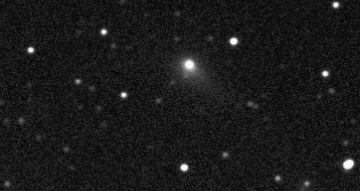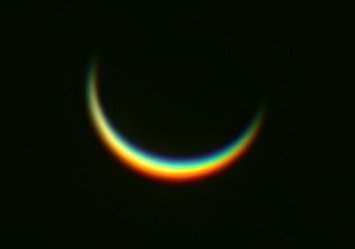 The space station is visible in the night sky this month. Would you like to see it? Sign up for SpaceWeather PHONE.
The space station is visible in the night sky this month. Would you like to see it? Sign up for SpaceWeather PHONE.
THE SUN: Amateur astronomers using safely-filtered solar telescopes should keep an eye on the sun's western limb in the days ahead. A long dark solar filament is about to turn into a glowing red solar prominence. Why? The sun's 27-day spin is rotating the filament so that it sticks out into the dark of space where we can easily see its beautiful red glow.
CROWDED NEIGHBORHOOD: The Solar System is mostly empty space. So what are the odds of photographing a comet and catching an asteroid in the same exposure? It happened to Mike Holloway on Jan. 4th. "I was imaging comet C/2005 E2. After processing the images I noticed a companion." Look carefully at the two-frame animation, below:

"At first I thought it was a piece of the comet," Holloway continues, "but I realized that the two were moving at slightly different rates." The mystery object turns out to be asteroid 253 Mathilda, about 45 million kilometers beyond the comet. Empty space, indeed!
VENUSIAN RAINBOW: Venus is hanging low in the sunset sky: map. Amateur astronomers who've looked at it lately have noticed something extraordinary: Venus looks like a rainbow. This picture comes from Ron Wayman of Tampa, Florida:

Venus on Jan. 3rd, seen through an 8-inch telescope: video.
Venus has phases, and at the moment it is a crescent. That explains the shape. But what about the colors?
Atmospheric optics expert Les Cowley has the answer: "Our atmosphere is curved around the Earth and acts as a huge lens," he explains. "It bends the rays from objects close to the horizon so that they appear higher in the sky than they actually are. Blue and green light are bent more than red light. The result: the blue/green image of Venus rides highest in the sky while the red image hangs lowest, producing an upper blue/green rim and a lower red rim. Our giant lens is also unsteady and sometimes we see Venus rippling and flashing all the colors of the rainbow."
To illustrate the unsteadiness of the atmosphere, Ron Wayman prepared a video. "This is what I saw in the telescope and the LCD screen of my Nikon CP995 camera," says Wayman. [video]
more images: from Frédéric Caron of Victoriaville, Quebec (Jan. 3); from Denis Joye near Paris, France (Jan. 2); from Ron Hodges of Midland, Texas (Jan. 2);

